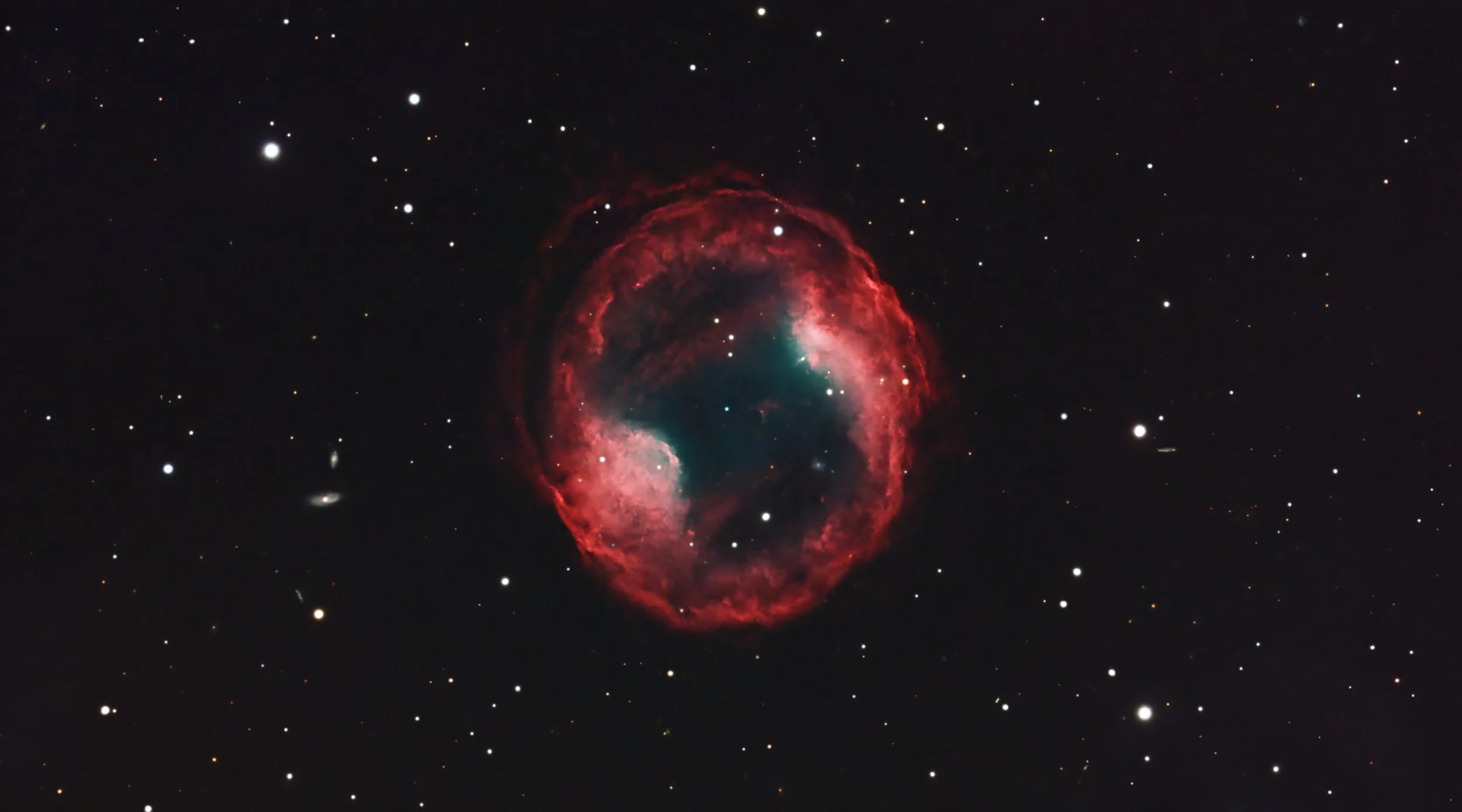
AAPOD2 Image Archives
Sort 2025 By Month: January | February | March | April | May | June | July | August | September | October | November | December
Jones-Emberson 1
Captured from a backyard observatory in Romano d’Ezzelino, Italy, under the light-polluted Bortle 7/8 skies, this image showcases Jones-Emberson 1 (PK 164+31.1), a faint planetary nebula located approximately 1,600 light-years away in the constellation Lynx. Nicknamed the "Headphone Nebula" due to its distinctive shape, this relic of a dying star’s outer layers appears as a delicate bubble of ionized gas, glowing faintly against the backdrop of space.
The nebula, around four light-years across, is a testament to the star's final stages of life. At its heart lies a fading white dwarf, the exposed core of the progenitor star that has shed its outer layers. The intricate structure and subtle colors in the nebula result from the interaction of ultraviolet radiation from the white dwarf with the surrounding gas, causing it to fluoresce in blues and greens, particularly in oxygen emission lines.
Imaging this elusive object from a bright suburban sky was a challenge, but careful planning and advanced post-processing brought its delicate features to life. Despite the light pollution, the faint circular shell and central star are clearly resolved, a testament to the dedication and skill of the astrophotographer.
Fun Fact: Jones-Emberson 1 was first cataloged in 1939 by R.C. Jones and R.A. Emberson. Unlike more famous planetary nebulae like the Ring or Dumbbell Nebula, it remains a lesser-known gem, often eluding amateur astronomers due to its low surface brightness.
Jones 1 Planetary Nebula PN.G104.2-29.6
Image Description and Details :
I captured Jones 1 back in 2019, but wanted to really add on more data to not only bring out more detail, but that Ha off to the side as well: The planetary nebula Jones 1 (Jn 1, PK 104-29.1, VV '578) was discovered in 1941 by the American astronomer Rebecca Jones on photo plates of the Harvard Observatory. Two years earlier, together with Richard M. Emberson, she discovered another planetary nebula: Jones-Emberson 1 (PK 164+31.1) in the constellation Lynx. The designation PK 104-29.1 comes from the two Czechoslovak astronomers Luboš Perek and Luboš Kohoutek, who in 1967 compiled a catalog of all the planetary nebulae of the Milky Way known at the time. The designation VV '578 goes back to the Russian astronomer Boris Vorontsov-Velyaminov, who studied and classified planetary nebulae in addition to cataloging galaxies. Jones 1 is a large planetary nebula with an angular diameter of 320 arcseconds, but a faint with only 15 magnitudes. The central star is 16.8 magnitudes bright. Distance measurements range from 716 pc to 826 pc (around 2300 to 2700 light years).
Copyright: Douglas J Struble
Jones-Emberson 1
Image Description and Details :
Jones-Emberson 1, a.k.a the Headphone Nebula, is a northern planetary nebula. It is also catalogued as PK 164+31.1. It is located about 1600 light years away in Lynx. The red and green glows are mainly due to emissions from hydrogen and oxygen atoms, respectively. The nebula’s brightness is listed as magnitude 14.1, but it is relatively large, so the light is spread out and it has a very low surface brightness.
This image includes galaxies that lie millions of light years away, thousands of times further away than the nebula. Look for streaks and smudges that look obviously different from the sharper, rounder stars.
Acquisition, focusing, guiding and control of Paramount MX mount with TheSkyX. Focus with Optec DirectSync motor and controller. Automation with CCDCommander. Equipment control with PrimaLuce Labs Eagle 3 Pro computer. All pre-processing and processing in PixInsight. Acquired from my SkyShed in Guelph. Minimal moonlight, above average transparency and average or better seeing. Data acquired March 21-April 13, 2021.
Luminance and Narrowband: Sky-Watcher Esprit 150 f/7 refractor and QHY 16200-A camera with Optolong UV/IR, Ha and O3 filters
Chrominance: Takahashi FSQ-106 ED IV @ f/3.6 and QHY367C Pro one-shot colour camera with Optolong UV/IR filter
Narrowband:
Luminance: 32 x 10m = 5hr20m
Ha: 42 x 10m = 7hr00m
O3: 38 x 10m = 6hr20m
Chrominance: 159 x 5m = 13hr15m
Total: 31hr55m
Image scale 1.15 arcsec per pixel (based on Luminance and narrowband resolution)
Copyright: Ron Brecher




